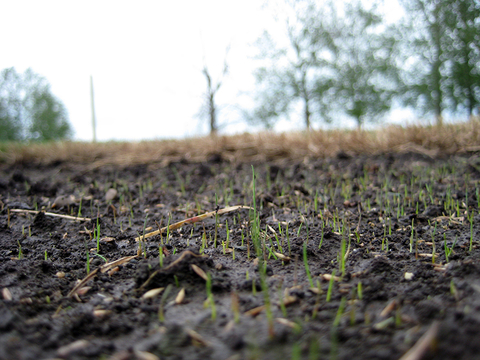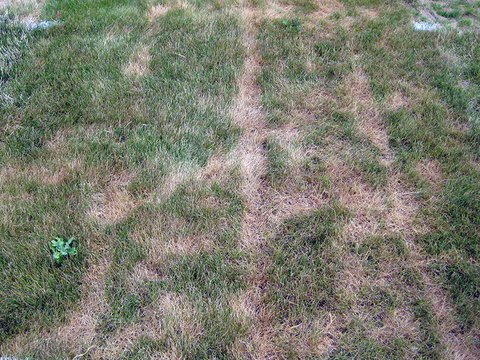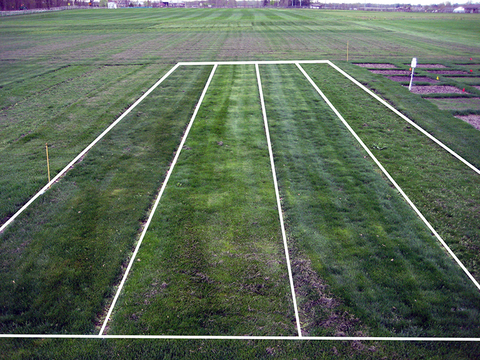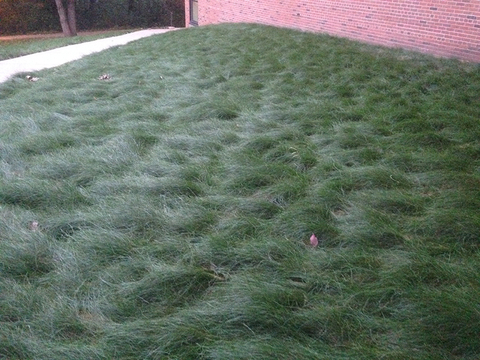Quick facts
- Strong creeping red fescue, slender creeping red fescue, Chewings fescue, hard fescue and sheep fescue are often grouped together and are called fine fescues.
- Fine fescues need very little irrigation in Minnesota.
- Mow fine fescues at 2.5 to 4 inches.
- Mow more often during cool, wet weather. Mow less often during hot or dry weather.
- Leave mowing clippings on the lawn.
- Practice a low to moderate nitrogen fertilization program, mostly applied in the fall.
- A higher mowing height and proper fertilization will help reduce weeds and the need for pesticides.
Fine fescues
Are you interested in doing less work on your lawn? You might want to consider using more fine fescues in your yard. The fine fescues are turfgrasses that:
- Have lower maintenance requirements (less mowing, watering and fertilizer) compared to more commonly grown Kentucky bluegrass.
- Tolerate shade better than other cool-season turfgrasses.
- Are well-adapted to most growing conditions in Minnesota.
Fine fescue turfgrasses are grouped together because their narrow leaves look similar. In fact, they can be challenging to tell apart. The fine fescues include these five turfgrasses:
- Strong creeping red fescue
- Slender creeping red fescue
- Chewings fescue
- Hard fescue
- Sheep fescue
Fine fescues can be grown in a blend with each other or as a mixture with other cool-season turfgrasses in home lawns with full sun to shaded conditions throughout Minnesota. One benefit of these turfgrasses is their excellent shade tolerance.
Although these five turfgrasses are often grouped together, there are differences among them, such as in growth habit, color and shade tolerance. There are a few differences in managing them (mowing, fertilization, irrigation and pest control) as well.
Understanding the subtle differences among these five turfgrasses and their management practices will help you use fine fescues to improve your lawn's overall quality and sustainability.
Characteristics of the five fine fescues
| Fine fescue | Growth habit | Color | Shade tolerance |
|---|---|---|---|
| Strong creeping red | Rhizomes | Medium green | Good to excellent |
| Slender creeping red | Rhizomes | Light to medium green | Good to excellent |
| Chewings | Bunch; rarely has rhizomes | Medium green | Excellent |
| Hard | Bunch | Dark gray-green to blue-green | Good |
| Sheep | Bunch | Powdery blue-green | Fair to good |
Establishing a fine fescue lawn
In Minnesota, the three most commonly used fine fescues are hard fescue, Chewings fescue, and strong creeping red fescue. If your lawn is in full sun, you should use a mixture that is approximately 40% hard fescue, 40% Chewings fescue, and 20% strong creeping red fescue (by weight).
If you have a lawn with a lot of tree shade, then you should use a mixture that is approximately 40% Chewings fescue, 40% strong creeping red fescue, and 20% hard fescue. But be aware that you may not find commercial mixtures that match these percentages exactly.
The term cultivar, which is commonly used for lawn grasses, is equivalent to the term variety. New and improved turfgrass cultivar seed is constantly created and marketed. There are many cultivars that are adapted to the growing conditions in Minnesota, but it is important to identify and select top-performing cultivars for our region to increase the likelihood of long-term success of your lawn and potentially reduce the use of water, fertilizer and pesticides as well as mowing.
See Finding the right grass seed for tips on what to look for when you are buying turfgrass seed.
You might already have some fine fescue in your lawn if it was started from seed. But if you are interested in starting a lawn that only has fine fescues, there are a few things to know when establishing it. Most of the renovation or overseeding practices are the same as described in the instructions for seeding in Seeding and sodding home lawns and in Lawn renovation for bee lawns.
The best time to seed a fine fescue lawn is the same as other turfgrass lawns, which in Minnesota is early August to late September. Fine fescues can also do well when dormant seeded.
The seeding rate for turfgrass depends on which turfgrass species is used. For fine fescues, the recommended rate is around 3 to 6 pounds of seed per 1,000 square feet.
If you ever have started a lawn from seed, you might have noticed that some seed grows faster. As a general rule, fine fescues establish faster than Kentucky bluegrass and tall fescue, but not as fast as perennial ryegrass.
Even within the fine fescues, they may establish at different speeds, with strong creeping red fescue, slender creeping red fescue, and Chewings fescue growing faster than hard and sheep fescue.
Fine fescues generally take five to 12 days to germinate after seeding under ideal conditions.
Lawns in Minnesota are often established using a starter fertilizer that contains nitrogen, phosphorus, and potassium. But recent research has shown that the fine fescues do not benefit from starter fertilizer during establishment. This means a starter fertilizer application with phosphorus is not needed unless a soil test indicates a lack of phosphorus.
A fertilizer containing nitrogen, but without phosphorus, will help fine fescue establishment. An example of what you might see on the fertilizer label would be 32-0-4, which corresponds to the percentages of nitrogen, phosphorus and potassium. Note the "0" means no phosphorus is in this formulation.
From 0.25 to 1 pound of nitrogen (N) per 1,000 square feet during the first two months after seeding will help fill in bare areas more quickly. Once the turfgrass has completely filled in and regular mowing is required, then follow the directions in the Fertilizing section below.
Managing a fine fescue lawn
The table below shows how the individual fine fescues respond to various management practices and stresses.
| Fine fescue | Tolerance of lower mowing heights | Traffic/wear tolerance | Annual nitrogen fertilization | Drought resistance | Resistance to weed invasion |
|---|---|---|---|---|---|
| Strong creeping red | Good | Poor to fair | Low to moderate | Good | Good to excellent |
| Slender creeping red | Good to excellent | Good | Low to moderate | Good to excellent | Good to excellent |
| Chewings | Good to excellent | Good | Low to moderate | Good to excellent | Good to excellent |
| Hard | Fair | Fair to good | Low | Excellent | Poor to good |
| Sheep | Fair | Poor to fair | Low | Excellent | Poor to good |
You should mow fine fescues above 2 inches, preferably 2.5 to 4 inches. Mowing at this height will help reduce weed invasion.
In general, mow as often as needed to maintain the desired height of cut, but avoid removing more than 1/3 of the leaf blade during any single mowing. Let the clippings return to the turf surface to supply nutrients to the soil. Avoid "clumping" of excessive clipping buildup on the lawn surface. See What to do with lawn clippings for more on managing lawn clippings.
If your yard has areas of shaded fine fescue turfgrass, mow the shaded areas at a slightly higher height of cut (1/2 to 1 inch higher) than turfgrass areas in full sun.
Mowing or heavy traffic on fine fescue turf during drought can cause extensive damage, which resembles small pitted areas ranging from baseball-sized to softball-sized areas or mower line tracks. In general, do not mow turfgrass that is under mild or severe drought conditions and only mow in summer months following at least 1 inch of rainfall or irrigation to make sure that no moisture stress is present.
For more information about mowing, see Mowing practices for healthy lawns.
Fine fescues will grow well with less fertilizer. For established fine fescue lawns:
- Nitrogen fertilization should be 1 to 2 applications per year, for a total of 1/2 to 2 pounds of nitrogen per 1,000 square feet per year throughout the growing season, and should not exceed 2 pounds of nitrogen per 1,000 square feet per year. This is similar to the recommendations for a low-maintenance lawn in Minnesota.
- Do not apply more than 1 pound of nitrogen per 1,000 square feet with a quick-release nitrogen fertilizer at one application.
- Fertilizer rates over 2 pounds of nitrogen per 1,000 square feet per year can decrease fine fescue turfgrass quality and encourage turfgrass diseases and weeds.
- Hard fescue and sheep fescue can thrive at lower nitrogen fertilization levels than other fine fescues.
- Overall, the best time to fertilize fine fescues is late August through early October and the second best time is May through late June.
- Avoid fertilization during the summer (July-August).
- Fine fescues tolerate a wide range of soil pH and poor soil conditions.
From left to right: strong creeping red fescue, slender creeping red fescue, Chewings fescue, and hard fescue plots
Fine fescue lawns seldom need to be watered. In fact, they generally prefer drier soil conditions. Irrigation during brief summer drought periods is not necessary, as fine fescue lawns will usually recover with rainfall and cooler temperatures in the fall.
But if a drought continues for several weeks, you should not completely stop watering in midsummer. Fine fescues can go up to 4 weeks without rain before needing to be watered 1/2 inch to keep crowns alive.
If you want to keep the grass from going completely brown during a drought, water deeply and infrequently. Soak the soil to a depth of several inches, and then allow the grass to start turning brown before irrigating the next time.
Minimize foot and mower traffic on these lawn areas when the fine fescue is under heat and drought to prevent damage from equipment (cart and mower) and foot traffic.
Due to the bunch-type growth habit, there is less potential for excessive thatch problems with Chewings, hard, and sheep fescue. If fine fescue turfgrass areas contain strong creeping red fescue or slender creeping red fescue, then thatch removal may be required once every 3 to 5 years.
Aerate or dethatch when the lawn is actively growing. The best time to do it in Minnesota is from mid-August through September. Avoid cultivation practices (renovation, dethatching, and aerification) during June, July, and early August.
You can remove thatch by core aerification to help remove organic matter and lessen compaction to improve rooting, water infiltration and soil aeration.
Power raking is an alternative thatch removal option, but it is more damaging to the turf and produces debris that must be removed. Plus, it does not alleviate soil compaction often found in urban soils.
Instead, use core aerification for thatch removal. See more about how to control thatch in your lawn.
Weeds
A higher mowing height and the proper amount of fertilizer will help reduce weed invasion. The best defense against weeds is a healthy lawn. Small patches of weeds, especially easy-to-pull annual ones such as crabgrass or prostrate knotweed, can be removed by hand. If herbicides are needed, be sure to follow all label directions and apply the proper rate and timing of the year for best control.
Diseases
Common diseases of fine fescues include summer patch, snow molds, red thread, pink patch, and dollar spot. Each of these diseases typically occurs at a specific time of the year when environmental conditions favor the disease. Proper management will typically help prevent or reduce most of these diseases. Fungicides are rarely necessary for home lawns, commercial properties, or other low-input turf areas.
Insects
Insect pests of fine fescues include white grubs and billbugs, though billbug damage is rare in Minnesota. Insects that damage turf are active in the summer months so start scouting for insect pests in early June into July. If the lawn has a history of white grub damage, you may need to apply an insecticide as a preventative in mid-June to early July or as a curative treatment in late July to mid-September when insect damage is evident. Any insecticide application should be handled by a professional lawn care company.
Most insects found in lawns don’t cause damage so make certain that pests are properly identified before using an insecticide that could harm beneficial insects such as pollinators. The correct timing of pesticides is important to ensure effectiveness.
CAUTION: Mention of a pesticide or use of a pesticide label is for educational purposes only. Always follow the pesticide label directions attached to the pesticide container you are using. Be sure that the area you wish to treat is listed on the label of the pesticide you intend to use. Remember, the label is the law.
No-mow and low-mow lawns
You may have been intrigued by the thought of a lawn that doesn’t need mowing. A no-mow or reduced-mow lawn is a low-input lawn that is allowed to grow to a higher height than normal. Fine fescues are the kind of turfgrasses that are used in no-mow and reduced-mow lawns. No-mow seed mixtures generally contain several of the fine fescues and may or may not be much different than fine fescue seed mixtures intended for general lawn uses.
Some mowing required
No-mow may be misleading, as you would typically mow this type of lawn to remove dead foliage at least once in the fall to maintain a neater appearance, reduce snow mold damage, and promote spring green-up. You also can mow in the late spring to remove the seed heads if you don't like how they look.
For more on mowing requirements of a no-mow lawn, see Mow the no-mow?
Planting a no-mow lawn
A fine fescue seed mixture for minimal-to-no mow lawns will depend on if your site is sunny or shady.
- For sunny sites, the mixture should have a higher ratio of hard, sheep, and/or Chewings fescue. These are the bunch type fine fescues.
- For shady sites, the mixture should have more strong creeping red fescue, slender creeping red fescue or Chewings fescue than hard fescue or sheep fescue.
The seeding rate for no-mow lawns is 3 to 5 pounds per 1,000 square feet. These lawns are otherwise established the same as a regular fine fescue lawn.
Another type of low-input fine fescue lawn that may be mowed less often is a bee lawn. For more information on bee lawns, see Planting and maintaining a bee lawn.
Bauer, S. 2016. No-Mow Landscapes. https://turf.umn.edu/news/no-mow-landscapes
Braun, R.C., Braithwaite, E.T., Kowalewski, A.R., Watkins, E., Hollman, A.B., & Patton, A.J. (2022). Nitrogen fertilizer and clover-inclusion effects on the establishment of fine fescue taxa. Crop Science, 62(2):947-957. https://doi.org/10.1002/csc2.20704
Braun, R. C. and Patton, A. J. (2022). Management of Fine Fescues. Purdue University Extension, Publication TURF-65-W. https://www.extension.purdue.edu/extmedia/TURF-65-W.pdf
Braun, R. C. and Patton, A. J. (2022). Fine Fescue Maintenance Calendar. Purdue University Extension, Publication TURF-13. https://www.extension.purdue.edu/extmedia/TURF-13-W.pdf
Braun, R. C. and Patton, A. J. (2022). Establishment of Fine Fescues. Purdue University Extension, Publication TURF-64. https://www.extension.purdue.edu/extmedia/TURF-64-W.pdf
Braun, R.C., Patton, A.J., Braithwaite, E.T., & Kowalewski, A.R. (2020). Establishment of low-input turfgrass from seed with patch and repair mixtures: Mulch and starter fertilizer effects. Crop Science, 60, 3362–3376. https://doi.org/10.1002/csc2.20266
Braun, R. C., Patton, A. J., Watkins, E., Koch, P., Anderson, N. P., Bonos, S. A., & Brilman, L. A. (2020). Fine fescues: A review of the species, their improvement, production, establishment, and management. Crop Science, 60,1142–1187. https://doi.org/10.1002/csc2.20122
Patton, A., Braun R., Reiter, M., Watkins, E., Kowalewski, A., Koch, P. and Murphy, J. (2022). Fine Fescues in Minimal-to-no Mow Areas. Purdue University Extension, Publication TURF-67-W. https://www.extension.purdue.edu/extmedia/TURF-67-W.pdf
Schwab, R. 2021. Mow the no-mow? https://turf.umn.edu/mow-no-mow
Stace, C. A. (2019). New flora of the British Isles. 4th ed. C & M Floristics Middlewood Green, Suffolk, United Kingdom.
Reviewed in 2022






